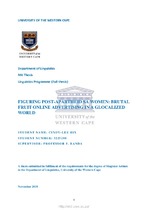| dc.description.abstract | In a developing country like South Africa plagued by historical racial scars, attitudes
pertaining to race, ethnicity and language, can be described as considerably problematic.
Images used for advertising (ads) and the media form part of the foundation through which
audience’s structure ideas about the normality and fluidity of race and ethnicity. Physical
appearance is especially important in the media and influences the minds of many young
people, especially young women and contributes to the way they feel about themselves. This
magnitude of influence reinforces the importance of analyzing these images and assessing the
implications it has on the South African society. Through a systemic functional multimodal
discourse analysis (SF-MDA), this thesis explores the way in which earlier (2004) and more
recent ads (2015) by Brutal Fruit have characterized and (re)characterised the ‘ideal’ South
African woman. Particular attention is placed on the concept of racialized bodies- skin
colour, hair, clothing and body types of the models employed during both periods when the
ads were published. The language(s) used in the ads are analysed which creates a platform for
engaging in issues related to transformation and inclusivity in society, as it is performed in
the ads. The literature focuses on the revolution of South African society, group
representation, race and the female body. The findings suggest that alcohol adverts largely
use semiotics that reinforce antifeminist rhetoric. However, in more recent ads there is an
attempt to compensate for the roles that have become available to women in the public
sphere. Women are shown to have more agency in that they are depicted in leading roles and
the narratives created about them relate that they are now in charge of their own sexuality.
The positive depiction of alcohol especially in relation to masculinity affects the number of
people who consume it. Alcohol consumption is linked to masculinity and power, however,
in society women are still expected to remain feminine. This is especially relevant for women
who aim to challenge dominant stereotypes about their position in society- and the use of
alcohol is an avenue that is used to achieve this. However, women consume ‘pink drinks’ and
not beer because ciders are still considered to be feminine by society, which is why many
men refuse to consume it. Finally, a true representation of real women in society needs to
become more popular in the media and a fresh approach to advertising alcohol especially to
women needs to be re-evaluated because these ads could be positive for women instead of
reiterating the usual derogatory stereotypes that society holds about women who do not
conform to dominant patriarchal conventions. | en_US |

